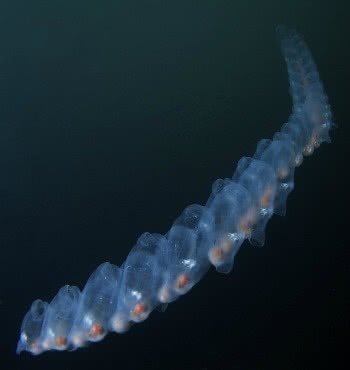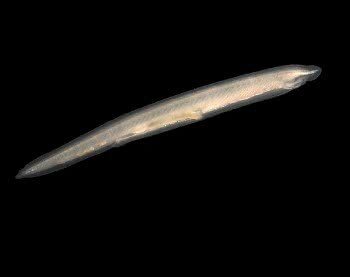The chordates represent the group of animals in the phylum Chordata. They are represented by some aquatic invertebrates and all vertebrates: fish, amphibians, reptiles, birds and mammals.
The main characteristic of this phylum is that, during the embryonic stage, all of them have a dorsal nerve tube, notochord, pharyngeal clefts and a post-anal tail.
In addition, they are triblastic, enterocoelomate, metamerized, deuterostomy, with lateral symmetry and present a complete digestive system.
String Classification
There are about 45 thousand known species of chordate, distributed in three subphyla: Urochordata (Urocordados), Cephalochordata (Cephalochords) and Craniate or Vertebrate.
The urochordates and cephalochords do not have a skull and spine, they are invertebrates. They are probably the most primitive chords and can be called Protocols (from the greek protos, first, primitive).
Craniates are all vertebrates and represent about 98% of the species in this phylum.
Sub-phylum Urochordata (Urocordados)
They are sessile marine animals that can live in isolation or in colonies. They are usually found stuck to rocks or larger algae. Its size can range from a few millimeters to 10 centimeters.
Its representatives are the salt marshes and sea squirts.

sals

sea squirt
Anatomy
The body is covered with a thick wrapping, called a tunic, made of tunicin polysaccharide. Due to this coating they can also be called tunicates.
The tunic has two openings: the inhalant siphon, through which the water penetrates the animal's body, and the exhaling siphon, through which the water returns to the environment.
food
For food, they filter plankton from the environment, which adhere to a mucus produced in a groove in the pharynx, the endostyle, and travel to the stomach and intestine, where nutrients are absorbed. Residues are eliminated through the anus, which opens in the exhalant siphon.
Breathing and Circulation
Through siphons, water continuously passes through the body, transporting oxygen to the body tissues and taking carbon dioxide and excretions abroad.
The circulatory system is partially opened and blood enters large blood bags, called sinusoids, where gas exchange takes place.
Nervous system
During the larval stage there is a nervous tube, located dorsally, from which nerves depart for various organs. In adulthood, this structure reduces to a nerve ganglion located under the pharynx, where the nerves depart.
reproduction
present sexual reproduction, being most of the monoecious species (hermaphrodite). Some may have asexual reproduction by budding.
Subphylum Cephalochordata (Cephalochordate)
They are marine animals with a body that is flattened laterally and tapered at the ends. They measure a few centimeters. They burrow into the sand, in a vertical position and leave only their mouths exposed, but they can swim in shallow water.
In general, its anatomy resembles that of a fish. However, they do not have a different head.
A striking feature of this group is the presence of a mouth, surrounded by filaments, called buccal cirrus.

amphioxus
food
Cephalochords filter the water that passes through your body through the pharynx. Food particles in the water adhere to mucus produced in a groove in the pharynx, the endostyle. This mucus, with the help of hair cells, goes to the intestine, where digestion takes place, since there is no stomach.
Breathing and Circulation
Cephalochordates have a closed circulatory system. The nutrition and oxygenation of cells are ensured by the presence of a heart in the ventral region, blood capillaries along the tissues and sinusoids.
When blood circulates through the network of capillaries, gas exchange occurs with the water that passes through the pharyngeal clefts. Oxygen gas and food are distributed to cells and carbon dioxide and excreta are collected.
Nervous system
It consists of a dorsal nerve tube from which branches spread throughout the body.
reproduction
They exhibit sexual reproduction and are dioecious. The gonads do not have ducts, so when they mature they break and release the gametes into a cavity called the atrium, between the digestive tube and the body cavity.
From there, the gametes leave the body and external fertilization occurs.
Craniata subphylum
They are the vertebrate animals. A striking feature of craniates is the presence of an endoskeleton. This structure protects the central nervous system and allows the body to move, integrating with the muscular system.
Craniata Subphylum Classification
The classification of vertebrates is not unanimous among scientists.
Traditionally, there are two superclasses:
THE agnatha (animals without jaws in the mouth), with few species and two classes:
- Myxine (witch fish)
- Petromyzontide (lampreys).
AND Gnathostomate (mandible animals), with varied species.
Among the gnathotomates, the main classes are:
- Chondricthyes: fish cartilaginous (sharks, rays, sharks and chimeras);
- Actinopterygii or Osteicthyes: bony fish (sardines, seahorses, catfish, puffer fish, among others);
- actinistia or Sarcopterygii: lobe-finned fish (coelacanths);
- dipnoi: lungfish (piramboa);
- Amphibia: amphibians (frogs, frogs, tree frogs, salamanders);
- reptile: reptiles (snakes, lizards, alligators, turtles, among others);
- birds: birds (chickens, toucans, ostrich, ducks, among others)
- Mammalia: mammals (monkeys, horses, oxen, elephants, dogs, humans, among others).
Read more about the Animal Kingdom.


